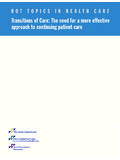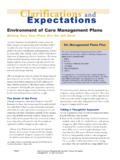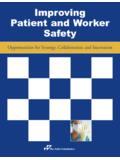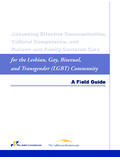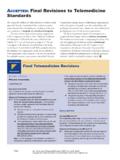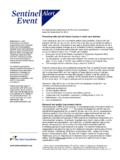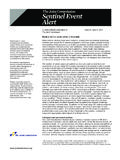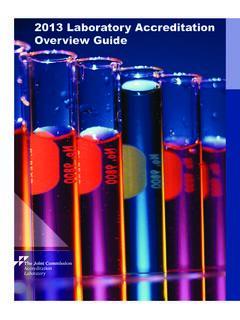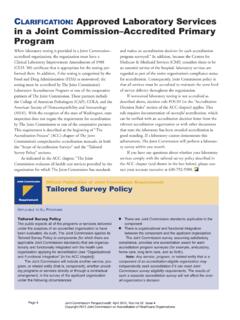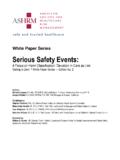Transcription of The oint Commission Perspectives
1 Joint CommissionPerspectives June 2018 l Volume 38 | Number 6 THE OFFICIAL NEWSLETTER OF THE JOINT COMMISSIONC opyright 2018 The Joint CommissionPerspectives , June 2018, Volume 38, Issue 61 Safety Culture Assessment: Improving the Survey Process5 Improving the Reliability and Consistency of Surveys7 Accreditation Participation Requirement Added for Deemed Status Organizations9 Correlation Change for Citing Ligature Deficiencies: Same EP, Different CoP10 OSHA Requires Electronic Submission of Injury and Illness Data11 Clarifying Survey Team Composition for Pediatric Hospitals12 Consistent Interpretation14 Intracycle Monitoring Calls Suspended15 May JQPS Table of Contents18 In SightSafety Culture Assessment: Improving the Survey ProcessAs part of its commitment to promote high reliability in health care, The Joint Commission urges organizations to establish a safety culture that fosters trust in reporting unsafe conditions to ensure high-quality patient care.
2 A project recently completed by The Joint Commission addressed how to improve the assessment of safety culture during survey. Health care organizations and surveyors responded so positively to the project that The Joint Commission will implement survey process improvements in June 2018 for hospitals and critical access hospitals and in October 2018 for all other for Improved ProcessThe Joint Commission defines safety culture as the product of individual and group beliefs, values, attitudes, perceptions, compe-tencies, and patterns of behavior that determine the organization s commitment to quality and patient safety.
3 * While existing resources for establishing a safety culture include the work of the Joint Commis-sion Center for Transforming Healthcare and published materials such as the Patient Safety Systems (PS) chapter of the Comprehensive Accreditation Manuals, feedback from customers and surveyors iden-tified a critical next step in the high-reliability journey: Evaluate and improve how safety culture is assessed during the survey process.* The Joint Commission . Comprehensive Accreditation Manuals. Patient Safety Systems (PS) chapter. Oak Brook, IL: Joint Commission Resources, 2018 The Joint CommissionPerspectives , June 2018, Volume 38, Issue 6 What Is NOT ChangingResults of this project did not involve changes to standards or elements of performance (EPs).
4 Already familiar to organizations, the standards and EPs that relate to the high-reliability subdomains (see Table 1 ) remain is also no change to the survey methods; that is, The Joint Commission will con-tinue to follow the survey agenda with which organizations are already familiar. This means that surveyors and organizations will still engage in activities such as the Opening Confer-ence; Daily Briefings; Individual, System, and Program-Specific Tracers; Leadership Session; and Organization Exit 1. Five Components of a Safety Culture and Related Leadership (LD) RequirementsAssessmentStrengthening SystemsTrust/Intimidating BehaviorIdentifying Unsafe ConditionsAccountability/Just , EP 1: Leaders regularly evaluate the culture of safety and quality using valid and reli-able tools.
5 , EP 2: Lead-ers prioritize and imple-ment changes identified by the evaluation [of safety culture]. , EP 5: Lead-ers create and implement a process for man-aging behaviors that undermine a culture of , EP 4: Leaders develop a code of conduct that defines ac-ceptable behavior and behaviors that undermine a culture of , EP 3: The scope of the safety program in-cludes the full range of safety issues, from potential or no-harm errors (some-times referred to as close calls [ near misses ] or good catches) to hazard-ous conditions and sentinel , EP 6: The leaders provide and encourage the use of systems for blame-free inter-nal reporting of a system or process failure, or the results of a proactive risk assessment.
6 (See also , EP 5; , EP 3; , EP 8)Note: This EP is in-tended to minimize staff reluctance to report errors in or-der to help an orga-nization understand the source and re-sults of system and process failures. The EP does not conflict with holding indi-viduals accountable for their blamewor-thy errors. These components of a safety culture were identified by Joint Commission senior leadership in the fol-lowing article: Chassin MR and Loeb JM. High-reliability health care: getting there from here. Milbank Q. 2013;91(3):459 2018 The Joint CommissionPerspectives , June 2018, Volume 38, Issue 6 What IS ChangingThis project was about improving the survey process.
7 Process improvements include the following expectations:l An organization will be expected to include its most recent Safety Culture Survey with the required documents listed in the Survey Activity Guide. The surveyors will want to review this prior to the opening conference (or as early in the survey process as possible). Help-ful resources for completing a Safety Culture Survey include Sentinel Event Alert 57: The essential role of leadership in developing a safety culture and the accompanying info-graphic 11 Tenets of a Safety Culture. These resources suggest tactics such as board engagement, leadership education, goalsetting, staff support, dashboards and reports that routinely review safety data, and other resources that can be used to support safety culture On Survey Day One, the survey team will provide a link to the five-minute video Leading the Way to Zero.
8 The team will ask the organization to make the audiovisual arrange-ments necessary to show the video during the Leadership Session. (Some organizations may ask to view it again at the Organization Exit Conference). Surveyors can also show the video to small groups on their tablets if the organization s technology does not allow for a larger Surveyors will be tracing safety culture as a part of other survey activities and asking ques-tions to assess safety culture. See Table 2 for sample questions for assessing a safety Joint Commission will continue to evaluate this improved survey process and will keep you informed of any updates.
9 Questions may be directed to your organization s assigned Account Executive. PTable 2. Sample Questions for Assessing Safety CultureFor LeadershipFor StaffHow do you assess the culture of safety in your orga-nization? What instrument are you using?Have you ever completed a safety culture survey? Have you seen the results of a safety culture survey? Does your supervisor discuss the results?Do you include safety culture improvement goals in performance expectations for leaders? What about middle management?Is there a formal mechanism for reporting intimidat-ing behavior? Would you feel comfortable reporting intimidating behavior?
10 Do you have internal or external benchmarks?When an error occurs, do you have confidence that your leadership will take an appropriate look at how the system or process is accountable versus an individual?What quality improvement projects have you conduct-ed to improve your scores on safety culture?What process do you have in place for reporting close calls/near misses or an error that occurred but did not reach the patient? 2018 The Joint CommissionPerspectives , June 2018, Volume 38, Issue 6 Table 2. Sample Questions for Assessing Safety Culture (continued)For LeadershipFor StaffDoes the board set expectations for improving safety culture?
